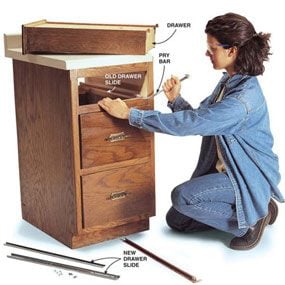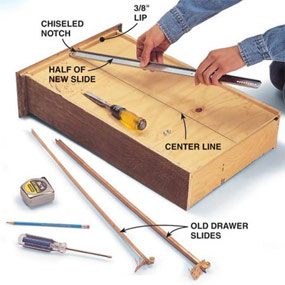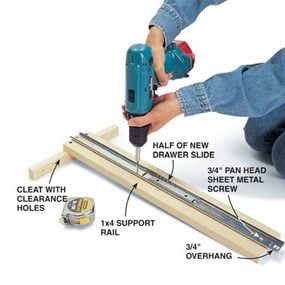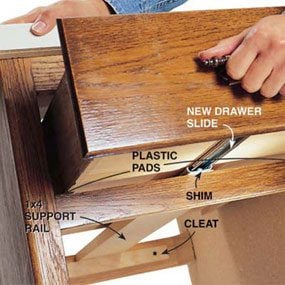How To Put A Ball Bearing Drawer Back In
Fixing Drawers: How to Make Creaky Drawers Glide
Replace worn out drawer slides with ball-bearing slides
 Family Handyman
Family Handyman
Don't let sticky drawers frustrate you. Replace worn-out slides with modern ball-bearing drawer slides to make your kitchen or bathroom drawers glide in and out.
You might also like: TBD
How to install ball-bearing-type drawer slides

Photo 1: Remove drawer and slides
Pry the old drawer slides from the cabinet and from the bottom of the drawer.

Photo 2: Attach new slide to drawer bottom
Draw a line down the center of the drawer bottom. If your drawer has a 3/8-in. lip, chisel a notch as shown. Align the top half of the slide over the center line and attach it to the drawer with one screw in front and one in back. The back of the slide will probably overhang the drawer.

Photo 3: Build support rail
Screw the bottom half of the drawer slide to the 1×4 support rail with 3/4 x No. 8 pan head sheet metal screws. Make sure the front of the slide overhangs the front of the wood rail 3/4 in. as shown.

Photo 4: Install support rail in cabinet
Shim the front of the drawer slide if necessary. Center the slide on the drawer opening and secure it with one screw in the front. Now adjust the back of the slide until it's level and square with the front of the cabinet. Then attach the back of the support rail to the back of the cabinet by driving 1-1/4 in. drywall screws through the predrilled clearance holes in the cleat.

Photo 5: Slide drawer into cabinet
Slide the drawer into the opening. Align the two halves of the drawer slide and push the drawer all the way in to connect them. Test the operation of the drawer. Remove the drawer and adjust the slides if necessary. Then tighten all of the screws.
You don't have to put up with creaky, sticking drawers. Replace your old worn-out drawer slides with the modern ball-bearing type. The drawers will roll so smoothly that you'll think you have new cabinets.
Most new side-mounting drawer slides require exactly 1/2 in. between the drawer side and the cabinet frame. The center mount slide we're using mounts to any drawer regardless of side clearance, which makes it a great choice for replacing old drawer slides.
We used 22-5/8 in. Accuride No. 1029 slides, but No. KV1129P22 are similar. Both come with a mounting bracket that can be screwed to the back of the cabinet to support the back of the drawer slide. But we decided to attach the slide to a wooden support rail instead (Photo 3). This stiffens the slide and gives the drawer better support when it's fully extended. Cut the 1×4 support rail to fit between the front frame and the back of the cabinet. We used a 1-in. wide cleat (Photo 3) to make it easier to attach the support rail to the back of the cabinet. Make sure this cleat doesn't interfere with the drawer below. If it does, fasten the 1×4 with metal angle brackets instead.
Measure the depth of your cabinet from the front of the frame to the back wall. Then check the drawer slide package to find the correct length. Standard depth kitchen cabinets require 22-5/8 in. slides. You'll also need four 1-1/4 in. drywall screws to attach the support rail to the cabinet.
Here are a few pointers and things to watch out for:
- Separate the two halves of the slides by extending them as far as possible and giving an extra tug.
- Measure the height of the lip on the bottom of the drawer (Photo 2). The drawer slide requires 1/4 in. If the lip is more than 1/4 in., make up the difference by shimming under the front of the bottom rail before you screw it to the cabinet. Our lip was 3/8 in., so we added an 1/8-in. shim (Photo 4).
- Two small plastic pads come with the drawer slide. Put one on each side of the drawer opening to keep the drawer from tipping. Fine-tune the drawer by adjusting the thickness of the shim under the bottom rail until the drawer sides barely touch the plastic pads.
- Don't tighten any screws until you've checked the operation of the drawer. Adjust the position of the slides until the drawer operates smoothly and the drawer front rests flush against the cabinet.
- Drawers like the one shown, with a 3/8-in. lip around the front, require a notch to allow the slide to be mounted flush with the front of the cabinet. Cut the notch with a sharp chisel.
Required Tools for this Project
Have the necessary tools for this DIY project lined up before you start—you'll save time and frustration.
Required Materials for this Project
Avoid last-minute shopping trips by having all your materials ready ahead of time. Here's a list.
Similar Projects
How To Put A Ball Bearing Drawer Back In
Source: https://www.familyhandyman.com/project/fixing-drawers-how-to-make-creaky-drawers-glide/
Posted by: carmichaelnower1967.blogspot.com

0 Response to "How To Put A Ball Bearing Drawer Back In"
Post a Comment